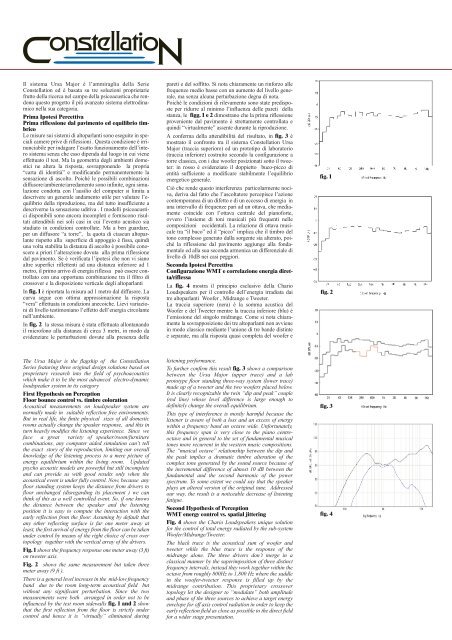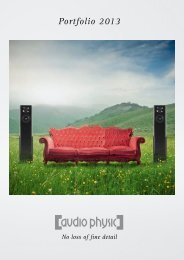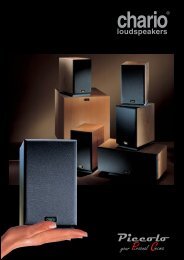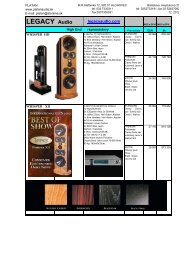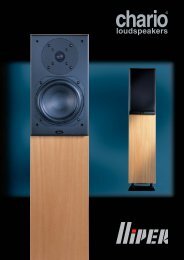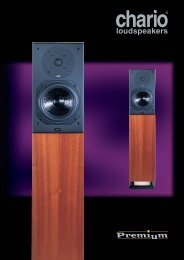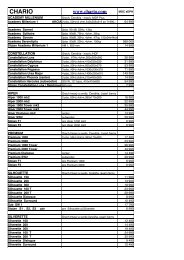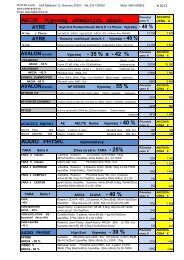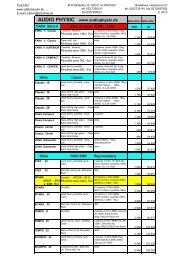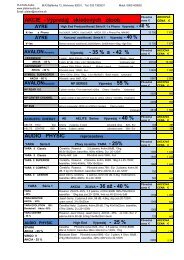t38 wave guide - Platan Audio
t38 wave guide - Platan Audio
t38 wave guide - Platan Audio
Create successful ePaper yourself
Turn your PDF publications into a flip-book with our unique Google optimized e-Paper software.
Il sistema Ursa Major è l’ammiraglia della Serie<br />
Constellation ed è basata su tre soluzioni proprietarie<br />
frutto della ricerca nel campo della psicoacustica che rendono<br />
questo progetto il più avanzato sistema elettrodinamico<br />
nella sua categoria.<br />
Prima Ipotesi Percettiva<br />
Prima riflessione dal pavimento ed equilibrio timbrico<br />
Le misure sui sistemi di altoparlanti sono eseguite in speciali<br />
camere prive di riflessioni . Questa condizione è irrinunciabile<br />
per indagare l’esatto funzionamento dell’intero<br />
sistema senza che esso dipenda dal luogo in cui viene<br />
effettuato il test. Ma la geometria degli ambienti domestici<br />
ne altera la risposta, sovrapponendo la propria<br />
“carta di identità” e modificando permanentemente la<br />
sensazione di ascolto. Poiché le possibili combinazioni<br />
diffusore/ambiente/arredamento sono infinite, ogni simulazione<br />
condotta con l’ausilio del computer si limita a<br />
descrivere un generale andamento utile per valutare l’equilibrio<br />
della riproduzione, ma del tutto insufficiente a<br />
descriverne la sensazione uditiva . I modelli psicoacustici<br />
disponibili sono ancora incompleti e forniscono risultati<br />
attendibili nei soli casi in cui l’evento acustico sia<br />
studiato in condizioni controllate. Ma a ben guardare,<br />
per un diffusore “a torre”, la quota di ciascun altoparlante<br />
rispetto alla superficie di appoggio è fissa, quindi<br />
una volta stabilita la distanza di ascolto è possibile conoscere<br />
a priori l’alterazione dovuta alla prima riflessione<br />
dal pavimento. Se è verificata l’ipotesi che non vi siano<br />
altre superfici riflettenti ad una distanza inferiore ad 1<br />
metro, il primo arrivo di energia riflessa può essere controllato<br />
con una opportuna combinazione tra il filtro di<br />
crossover e la disposizione verticale degli altoparlanti<br />
In fig. 1 è riportata la misura ad 1 metro dal diffusore. La<br />
curva segue con ottima approssimazione la risposta<br />
“vera” effettuata in condizioni anecoiche. Lievi variazioni<br />
di livello testimoniano l’effetto dell’energia circolante<br />
nell’ambiente.<br />
In fig. 2 la stessa misura è stata effettuata allontanando<br />
il microfono alla distanza di circa 3 metri, in modo da<br />
evidenziare le perturbazioni dovute alla presenza delle<br />
pareti e del soffitto. Si nota chiaramente un rinforzo alle<br />
frequenze medio basse con un aumento del livello generale,<br />
ma senza alcuna perturbazione degna di nota.<br />
Poiché le condizioni di rilevamento sono state predisposte<br />
per ridurre al minimo l’influenza delle pareti della<br />
stanza, le figg. 1 e 2 dimostrano che la prima riflessione<br />
proveniente dal pavimento è strettamente controllata e<br />
quindi “virtualmente” assente durante la riproduzione.<br />
A conferma della attendibilità del risultato, in fig. 3 è<br />
mostrato il confronto tra il sistema Constellation Ursa<br />
Major (traccia superiore) ed un prototipo di laboratorio<br />
(traccia inferiore) costruito secondo la configurazione a<br />
torre classica, con i due woofer posizionati sotto il tweeter:<br />
in rosso è evidenziato il doppietto buco-picco di<br />
entità sufficiente a modificare stabilmente l’equilibrio<br />
energetico generale.<br />
Ciò che rende questo interferenza particolarmente nociva,<br />
deriva dal fatto che l’ascoltatore percepisce l’azione<br />
contemporanea di un difetto e di un eccesso di energia in<br />
una intervallo di frequenze pari ad un ottava, che mediamente<br />
coincide con l’ottava centrale del pianoforte,<br />
ovvero l’insieme di toni musicali più frequenti nelle<br />
composizioni occidentali. La relazione di ottava musicale<br />
tra “il buco” ed il “picco” implica che il timbro del<br />
tono complesso generato dalla sorgente sia alterato, poiché<br />
la riflessione dal pavimento aggiunge alla fondamentale<br />
ed alla sua seconda armonica un differenziale di<br />
livello di 10dB nei casi peggiori.<br />
Seconda Ipotesi Percettiva<br />
Configurazione WMT e correlazione energia diretta/riflessa<br />
La fig. 4 mostra il principio esclusivo della Chario<br />
Loudspeakers per il controllo dell’energia irradiata dai<br />
tre altoparlanti Woofer , Midrange e Tweeter.<br />
La traccia superiore (nera) è la somma acustica del<br />
Woofer e del Tweeter mentre la traccia inferiore (blu) è<br />
l’emissione del singolo midrange. Come si nota chiaramente<br />
la sovrapposizione dei tre altoparlanti non avviene<br />
in modo classico mediante l’unione di tre bande distinte<br />
e separate, ma alla risposta quasi completa del woofer e<br />
fig. 1<br />
fig. 2<br />
The Ursa Major is the flagship of the Constellation<br />
Series featuring three original design solutions based on<br />
proprietary research into the field of psychoacoustics<br />
which make it to be the most advanced electro-dynamic<br />
loudspeaker system in its category<br />
First Hypothesis on Perception<br />
Floor bounce control vs. timbre coloration<br />
Acoustical measurements on loudspeaker system are<br />
normally made in suitable reflection free environments.<br />
But in real life, the finite physical sizes of all domestic<br />
rooms actually change the speaker response, and this in<br />
turn heavily modifies the listening experience. Since we<br />
face a great variety of speaker/room/furniture<br />
combinations, any computer aided simulation can’t tell<br />
the exact story of the reproduction, limiting our overall<br />
knowledge of the listening process to a mere picture of<br />
energy equilibrium within the living room. Updated<br />
psycho acoustic models are powerful but still incomplete<br />
and can provide us with good results only when the<br />
acoustical event is under fully control. Now, because any<br />
floor standing system keeps the distance from drivers to<br />
floor unchanged (disregarding its placement ) we can<br />
think of this as a well controlled event. So, if one knows<br />
the distance between the speaker and the listening<br />
position it is easy to compute the interaction with the<br />
early reflection from the floor. Assuming by default that<br />
any other reflecting surface is far one meter away at<br />
least, the first arrival of energy from the floor can be taken<br />
under control by means of the right choice of cross over<br />
topology together with the vertical array of the drivers.<br />
Fig. 1 shows the frequency response one meter away (3 ft)<br />
on tweeter axis.<br />
Fig. 2 shows the same measurement but taken three<br />
meter away (9 ft ).<br />
There is a general level increase in the mid-low frequency<br />
band due to the room long-term acoustical field but<br />
without any significant perturbation. Since the two<br />
measurements were both arranged in order not to be<br />
influenced by the test room sidewalls fig. 1 and 2 show<br />
that the first reflection from the floor is strictly under<br />
control and hence it is “virtually” eliminated during<br />
listening performance.<br />
To further confirm this result fig. 3 shows a comparison<br />
between the Ursa Major (upper trace) and a lab<br />
prototype floor standing three-way system (lower trace)<br />
made up of a tweeter and the two woofers placed below.<br />
It is clearly recognizable the twin “dip and peak” couple<br />
(red line) whose level difference is large enough to<br />
definitely change the overall equilibrium.<br />
This type of interference is mostly harmful because the<br />
listener is aware of both a loss and an excess of energy<br />
within a frequency band an octave wide. Unfortunately,<br />
this frequency span is very close to the piano centreoctave<br />
and in general to the set of fundamental musical<br />
tones more recurrent in the western music compositions.<br />
The “musical octave” relationship between the dip and<br />
the peak implies a dramatic timbre alteration of the<br />
complex tone generated by the sound source because of<br />
the incremental difference of almost 10 dB between the<br />
fundamental and the second harmonic of the power<br />
spectrum. To some extent we could say that the speaker<br />
plays an altered version of the original tune. Addressed<br />
our way, the result is a noticeable decrease of listening<br />
fatigue.<br />
Second Hypothesis of Perception<br />
WMT energy control vs. spatial jittering<br />
Fig. 4 shows the Chario Loudspeakers unique solution<br />
for the control of total energy radiated by the sub-system<br />
Woofer/Midrange/Tweeter.<br />
The black trace is the acoustical sum of woofer and<br />
tweeter while the blue trace is the response of the<br />
midrange alone. The three drivers don’t merge in a<br />
classical manner by the superimposition of three distinct<br />
frequency intervals, instead they work together within the<br />
octave from roughly 800Hz to 1,800 Hz where the saddle<br />
in the woofer-tweeter response is filled up by the<br />
midrange contribution. This proprietary crossover<br />
topology let the designer to “modulate” both amplitude<br />
and phase of the three sources to achieve a target energy<br />
envelope for off axis control radiation in order to keep the<br />
early reflection field as close as possible to the direct field<br />
for a wider stage presentation.<br />
fig. 3<br />
fig. 4


